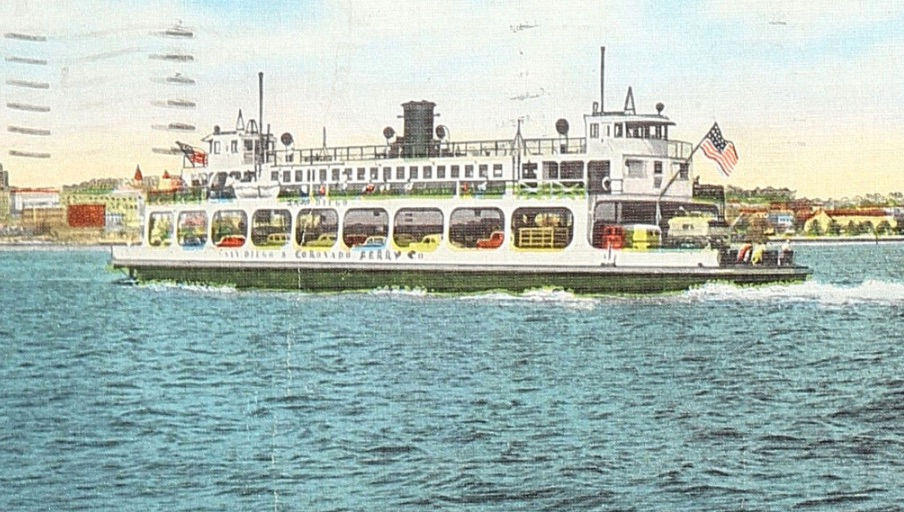Coronado Ferry to Upgrade to Electric Vessels / History of Ferries and Coronado Bridge
- Susan Heavilin
- Aug 20
- 3 min read

In the fall of next year, passengers will be getting a new ride across the bay.
The end of another era. The diesel-powered ferry boats that have transported passengers and bicycles between San Diego and Coronado since 1986 will be a thing of the past.
Flagship Enterprises will be be changing over to all-electric ferries at a cost of $21 million.
The switch to electric is expected to boost air quality in Barrio Logan and National City. That's a plus.
“This investment by the state of California in fully electric zero-emission ferries is a critical step toward cleaning our environment and reducing air pollution in San Diego,” said Assemblymember David Alvarez, D-San Diego.
The Coronado Ferry connects downtown San Diego to Coronado Island. There are two ferry docks on the San Diego side, Broadway Pier and the San Diego Convention Center, and one on the Coronado side, the Coronado Ferry Landing.

The cost of a ferry-ride ticket was $5 each way for many years but the price was raised to $9 last summer. Holy moly! Allegedly that was to cover increased costs of fuel and labor, with a few other amenities thrown in.
I used to travel on the Coronado Ferry when I lived in Coronado and had jury duty in San Diego. At that time, the first few rides of the day were federally-subsidized so my 15-minute ride across the bay was free. Once on the San Diego side, I would walk down Broadway to the Courthouse, stopping at Starbucks to grab a hot chocolate to sip on the way. At the end of the day, I would travel back across the bay to Coronado on another free voyage, using the voucher I had been given that morning. Easy peasy!

The Coronado Ferry was not always just for passengers. The first ferry—the Coronado—was the only way to travel between Coronado and San Diego unless you were an incredibly good swimmer.

"The Coronado Ferry Landing we know now is much different from the original in both location and the types of ferries in service. The first ferry boat was a steam-powered, side-paddle, and arrived at Coronado on August 19, 1886, appropriately named "The Coronado." At a cost of $15,000, the ferry could carry 600 people and 13 horse teams."—Sadie Coburn, Coronado Historical Association

This is how you got your automobile across the bay. And that's how it was done for over 100 years.
Then someone came up with the idea to build a bridge across the bay.
The construction of the San Diego-Coronado Bridge began in February 1967 and was completed in August of 1969. The cost of the construction was $50 million, approximately double the cost of the new electric ferries.
"To ensure any ships coming out of the San Diego Naval Base could pass under the bridge, the Navy supported its construction on the condition that the bridge would stand over 200 feet above the water. This would be a high enough clearance for even the largest of aircraft carriers. Architects puzzled over how to maintain the 200-foot clearance height without making it too steep for cars to pass over safely. To achieve this, the bridge needed to be longer than the distance between each shoreline. They landed on a solution that ended up giving the Coronado Bridge its defining characteristic: a curve! Coronado Bridge is also unique in that it has no overhead supports. Rather than constructing a suspension bridge, the plans called for 27 arch-like towers to act as supports, elevating and stabilizing the bridge."—Go Visit San Diego website
The bridge would change Coronado's "Mayberry RFD" atmosphere into something unrecognizable to children raised there before 1969.

The Coronado Bridge ribbon-cutting ceremony took place on August 2, 1969, officially opening the bridge to the public. Notable participants included Governor Ronald Reagan, Mayors Frank Curran (San Diego) and William Paul Vetter (Coronado).
"The ferries ceased operation Aug. 2, 1969, when the Coronado Bay Bridge opened for use. Under California law, ferry boats are banned from operating within 10 miles of a toll crossing. However, in 1986 the construction fees were paid off on the Coronado Bridge, so the toll was removed and the ferries began service again but now only transporting people and bikes."—Sadie Coburn, Coronado Historical Association

The commuter trips will continue, but will no doubt be a lot quieter.
As progress marches on, a morsel more of leisurely times disappears.










Comments